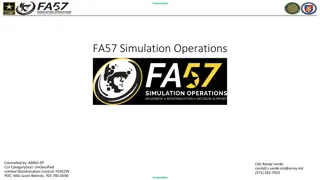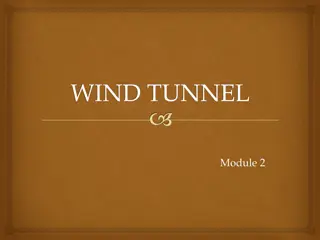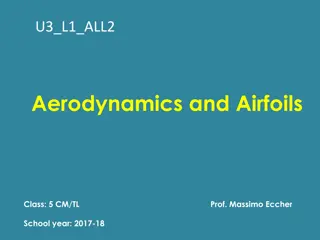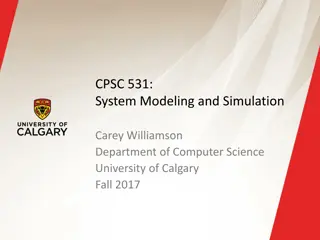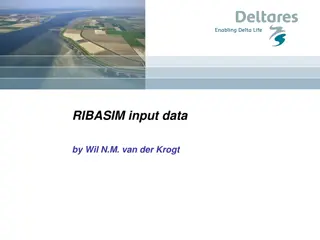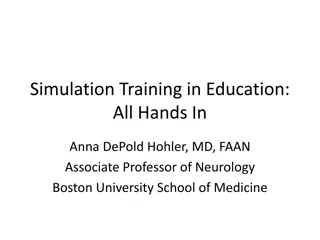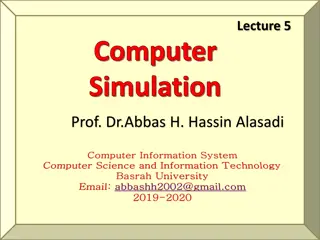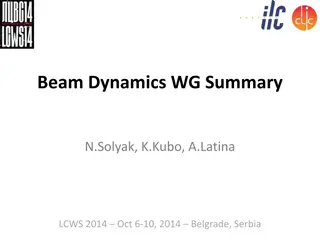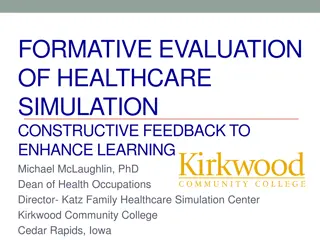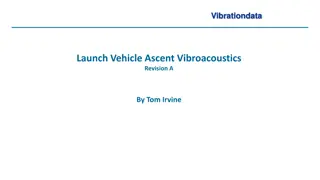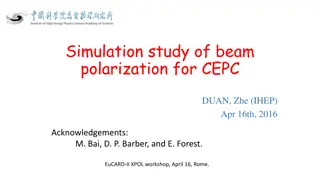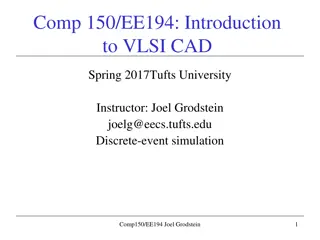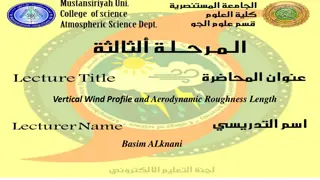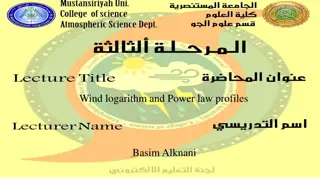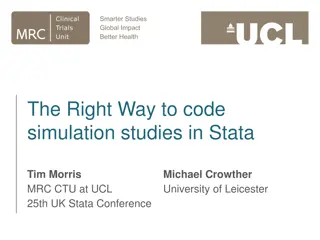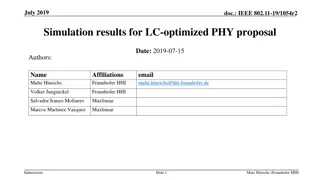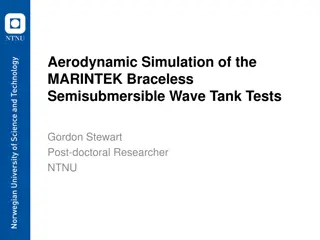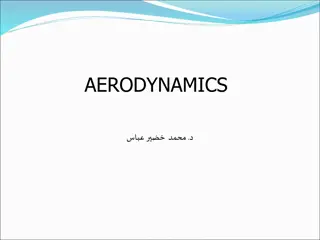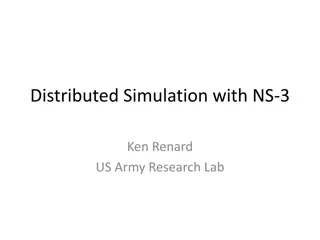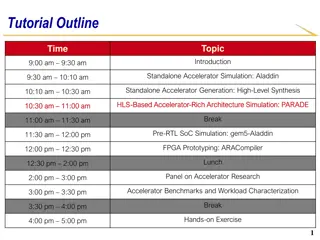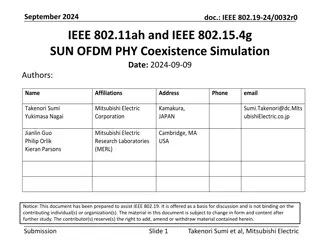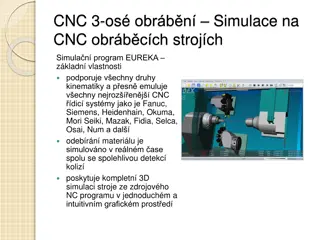System Modeling and Simulation Course Overview
This course covers the basics of systems modeling, discrete-event simulation, and computer systems performance evaluation. Topics include Monte Carlo simulation, probability models, simulation output analysis, queueing theory, and more. Professor Carey Williamson leads the course with a focus on pra
10 views • 21 slides
Overview of Army Modeling and Simulation Office
The U.S. Army Modeling and Simulation Office (AMSO) serves as the lead activity in developing strategy and policy for the Army Modeling and Simulation Enterprise. It focuses on effective governance, resource management, coordination across various community areas, and training the Army Analysis, Mod
3 views • 8 slides
Wind Tunnels: Devices for Aerodynamic Testing
Wind tunnels are devices that simulate air flows to test models under controlled conditions. They are classified as low-speed and high-speed tunnels, used to replicate flying or moving objects. Testing involves studying air motion using techniques like smoke visualization, colored threads, and speci
4 views • 37 slides
How to Check a Simulation Study: Methods and Considerations
Simulation studies are often used to evaluate statistical methods and study power, but they can sometimes produce misleading results. This work discusses strategies to assess and improve the quality of simulation studies, drawing on experiences and considerations outlined in relevant literature. A s
1 views • 31 slides
The Design of Airfoils and Wing Dihedral
The design of airfoils and wings involves key terminologies like mean chamber line, leading edge, trailing edge, chord line, and camber. Dihedral is an important aspect of wing design that affects stability and control. Aerodynamic forces on a wing, like lift and drag, are crucial for flight perform
5 views • 10 slides
System Modeling and Simulation Overview
This content provides insights into CPSC 531: System Modeling and Simulation course, covering topics such as performance evaluation, simulation modeling, and terminology in system modeling. It emphasizes the importance of developing simulation programs, advantages of simulation, and key concepts lik
4 views • 28 slides
Basin Manipulation Simulation Analysis Tool Overview
Basin Manipulation Simulation Analysis Tool provides a comprehensive solution for managing and analyzing basin data, including tasks like basin manipulation, simulation analysis, case management, and defining simulation time steps. The tool allows for easy data entry, visualization of simulation res
11 views • 17 slides
Simulation Training in Education: Enhancing Learning Through Hands-On Simulation
Hands-on simulation training in education provides students with valuable learning experiences by increasing self-reported knowledge and technical proficiency. Simulations help improve students' knowledge, experience, and comfort with challenging procedures in a lower-risk environment, leading to en
3 views • 13 slides
Computer Simulation and Modeling Tools
Computer simulation and modeling is essential for conducting studies in various fields. Selecting the right simulation language or package is crucial for accurate results. This involves considering the characteristics of the language, such as random number generation, process transformers, list proc
5 views • 7 slides
Advanced Beam Dynamics and Machine Protection in High-Energy Linacs
Overview of recent talks and discussions at LCWS 2014 in Belgrade, Serbia, focusing on machine protection, simulation codes, instrumentation, and system tests. Topics include beam-loss monitors, dark current measurements, simulation code developments, and beam dynamics studies in linacs. Key speaker
6 views • 12 slides
Enhancing Healthcare Simulation Through Constructive Feedback
Explore the principles and benefits of healthcare simulation, focusing on formative evaluation and constructive feedback to improve learning outcomes. Delve into the role of formative assessment tools, TeamSTEPPS model, and Mayo High Performance Teamwork Scale in simulation scenarios. Discover the s
2 views • 37 slides
Aeroacoustic Analysis of Launch Vehicle Ascent Dynamics
Investigate the vibroacoustics of launch vehicle ascent, focusing on the formation of turbulent boundary layers, aerodynamic excitation sources, and dynamic pressure coefficients. Learn about the transition to turbulent flow, shockwave formation, and the analysis steps involved in determining vibrat
4 views • 30 slides
Lift: The Aerodynamic Force in Airplanes
Lift is the aerodynamic force that opposes the weight of an airplane, keeping it airborne. It is generated by the motion of the aircraft through the air, with the wings playing a crucial role in lift production. The amount of lift depends on various factors like the shape, size, and velocity of the
7 views • 35 slides
Beam Polarization Simulation Study for CEPC
Simulation study on beam polarization for the Circular Electron Positron Collider (CEPC) using the PTC Poly- morphic Tracking Code. The study includes orbital and spin tracking, equilibrium polarization calculation, and Monte-Carlo simulation of depolarization rate. Comparison with other Monte-Carlo
6 views • 20 slides
Introduction to VLSI CAD and Discrete-Event Simulation at Tufts University
This course introduces students to event-oriented simulation, building virtual models, and validating designs through simulation. It covers the importance of simulation in testing and refining designs before implementation. Examples include simulating VLSI networks and exploring the use of discrete-
5 views • 32 slides
Vertical Wind Profiles and Aerodynamic Roughness Length
The interaction between wind and the Earth's surface affects wind profiles and aerodynamic roughness length. The nature of airflow over surfaces, changes in wind speed with height, and the concept of aerodynamic roughness length are explained. Techniques for estimating aerodynamic roughness length b
5 views • 8 slides
Wind Profiles and Aerodynamic Roughness Length
Wind profiles are crucial in understanding how wind speed changes with height in the boundary layer. The logarithmic and power law profiles depict this relationship, influenced by surface characteristics and obstacles. The aerodynamic roughness length, defining where wind speed becomes zero, remains
2 views • 14 slides
The Aerodynamics of Train Systems
The aerodynamic characteristics of high-speed railway trains are unique due to their long length, interaction with surrounding structures, and influence of cross-winds. Aerodynamic drag significantly impacts energy consumption, with the drag being proportional to the square of speed. Precise evaluat
4 views • 11 slides
The Right Way to Code Simulation Studies in Stata
Simulation studies in Stata involve using (pseudo) random numbers to generate data from a distribution for studying statistical methods. This process helps to evaluate different scenarios and understand the properties of statistical techniques. Key components like ADEMP (Aims, Data-generating mechan
12 views • 18 slides
Simulation Results for LC-Optimized PHY Proposal in July 2019
The document presents simulation results for an LC-optimized PHY proposal for TGbb based on G.9991 PHY. It includes details on the simulation setup, frame detection results, header modulation, coding simulation results, payload modulation, and coding simulation results. The setup involved various re
3 views • 18 slides
Aeroelasticity: Deformation and Aerodynamic Forces
Aeroelasticity explores the intricate relationship between the deformation of elastic structures in an airstream and the resulting aerodynamic forces. This field of study is vital for predicting and managing interactions between structural mechanics and aerodynamics in aircraft design. Historical in
4 views • 15 slides
Aerodynamic Simulation of MARINTEK Braceless Semisubmersible: Insights and Tools
Explore the aerodynamic simulation of the MARINTEK Braceless Semisubmersible through advanced techniques and tools. Discover the unique aerodynamic actuator, simulation models, and tools used in the research conducted by Gordon Stewart, a post-doctoral researcher at NTNU. Gain insights into the expe
3 views • 16 slides
Aerodynamic Forces and Moments in Fluid Dynamics
Introduction to aerodynamic forces and moments in the study of fluid dynamics, particularly focusing on air as the primary medium of interest. The discussion covers thermodynamic properties, continuum hypothesis, and fundamental principles of classical mechanics applied to the analysis of aerodynami
4 views • 35 slides
Aerodynamics: Fundamentals and Applications
Aerodynamics is the study of airflow around objects and its impact on forces and moments. This field covers fundamental principles, aerodynamic variables, forces and moments, practical objectives, and more. By exploring topics like flow similarity and dimensional analysis, aerodynamic engineers pred
4 views • 17 slides
AVATAR Project: Advancements in Aerodynamic Tools for Large Rotors
The AVATAR project, funded by the European Union's Seventh Programme, focuses on advancing aerodynamic tools for large wind turbines, specifically in the 10-20MW range. Led by a consortium of top research institutions and industry partners, AVATAR aims to elevate aerodynamic and fluid-structure mode
0 views • 16 slides
AVATAR Project - Advanced Aerodynamic Tools for Large Rotors
The AVATAR project, funded by the European Union, aimed to enhance aerodynamic models for 10-20MW wind turbines, focusing on offshore applications to reduce Levelized Cost of Energy (LCOE). Led by EERA, the consortium included top research institutions and industry partners. The project ran from Nov
0 views • 6 slides
Numerical Analysis of Aerodynamic Performances in Biplane Configuration
This paper presents a numerical investigation comparing single versus double wing (biplane) configurations for aerodynamic performances. Geometric models and numerical analyses were conducted, providing insights into the advantages and complexities of biplane wings. The study utilized computational
2 views • 12 slides
Distributed Simulation with NS-3
Explore the world of distributed simulation with NS-3 as presented in "Distributed Simulation with NS-3" by Ken Renard from the US Army Research Lab. Get insights into the application of NS-3 in creating advanced simulations for military research and beyond. Dive into the details of distributed simu
1 views • 38 slides
Aerodynamic Drag in Aircraft
Aerodynamic drag is a resistance force that opposes an aircraft's motion through the air. It is generated by every part of the airplane and depends on factors like object geometry, surface roughness, and air velocity. Factors affecting drag include object shape, motion through the air, and air prope
3 views • 14 slides
OR Teamwork Faculty Development Program
Center for Medical Simulation's program focuses on improving teamwork in operating rooms to enhance patient safety. The initiative aims to train interprofessional teams using simulation as a medium, positively influencing the OR's working culture. Supported by an insurance incentive from Harvard CRI
2 views • 12 slides
Data Modeling and Simulation by Dr. Fadi M. S. Alsuhimat
This presentation covers topics such as performance evaluation, simulation modeling, system taxonomy, terminology, simulation modeling development, advantages of simulation, and more. It delves into the concepts, processes, and benefits of data modeling and simulation in various systems and environm
1 views • 11 slides
Real-Time Simulation Executive for DARTS Lab Course
The Dynamics and Real-Time Simulation (DARTS) Laboratory is developing an exemplar simulation executive for their 2023 course. The simulation aims to create a dynamic vehicle assembly, set up data logging, run simulations in real-time, and render related models. The project outlines requirements, go
5 views • 42 slides
Vertical Wind Profile and Aerodynamic Roughness Length
Learn about the nature of airflow over different surfaces, the vertical wind profile in the boundary layer, and the significance of aerodynamic roughness length in determining wind speed behavior. Explore how aerodynamic roughness length is defined and its implications for various surfaces.
0 views • 8 slides
Accelerator-Rich Architecture: Research Tools and Simulation Techniques
Explore a comprehensive agenda covering various aspects of accelerator-rich architecture, from standalone simulation to FPGA prototyping. Key topics include Aladdin simulation, High-Level Synthesis (HLS) generation, PARADE architecture simulation, gem5-Aladdin SoC simulation, and more. Join the disc
1 views • 29 slides
Simulation Modeling for Decision Support
This module focuses on developing skills in modeling and simulation of business dynamics to aid decision-making, utilizing simulation software for discrete-event simulation and System Dynamics. The course includes lectures, practical exercises, group coursework, and essays to enhance students' under
0 views • 37 slides
Simulation for Decision Support: Business Dynamics & Decision-Making
Dive into the impact of organizational environment on decisions, develop simulation models, and enhance decision-making skills using DES and SD methods. Engage in practical exercises, group coursework, and essays to apply simulation approaches to real business scenarios. Gain knowledge and skills in
0 views • 10 slides
IEEE 802.19-24 Simulation Update for Coexistence of IEEE 802.15.4g and IEEE 802.11ah
Explore the simulation update for the coexistence of IEEE 802.15.4g and IEEE 802.11ah in the September 2024 document. The study focuses on smart utility use cases, presenting simulation parameters, performance metrics, and the background of the study. Dive into the details of simulation models, depl
2 views • 14 slides
DARTS Lab: Simulation Objects, Data Access, and DVar Layer
Explore the Dynamics and Real-Time Simulation (DARTS) Laboratory's run-time data access, simulation objects, DVar documentation, and the importance of the DVar layer in providing standardized access to rich data for simulation objects. Discover the significance of this layer in decoupling services f
3 views • 21 slides
Cutting-Edge CNC Simulation Software for Machining Excellence
Discover EUREKA simulation software, a versatile tool for CNC machining simulation with advanced features supporting various kinematics and precise emulation of top CNC control systems. Experience real-time material simulation, collision detection, and complete 3D machine simulation in an intuitive
2 views • 12 slides
Understanding Wing Design and Aerodynamics: Terminology and Concepts
Explore the intricate world of aerodynamics and airfoil design, diving into terminology such as mean chamber line, leading edge, trailing edge, chord line, camber, and more. Learn about the aerodynamic force on a wing, resolving aerodynamic forces for rockets, and the variation of lift, drag, and mo
0 views • 10 slides

